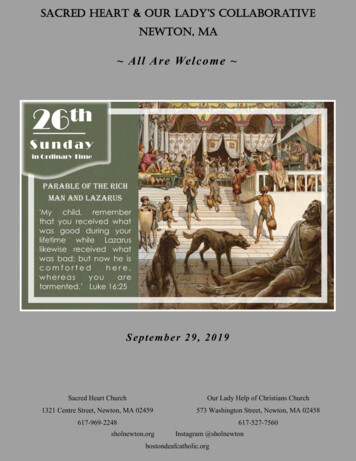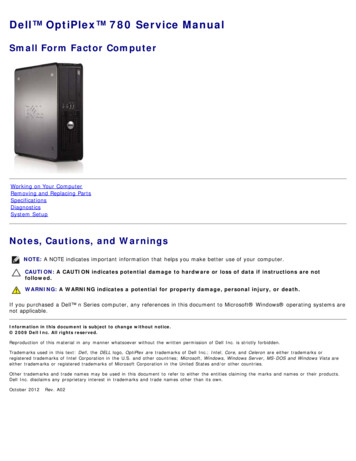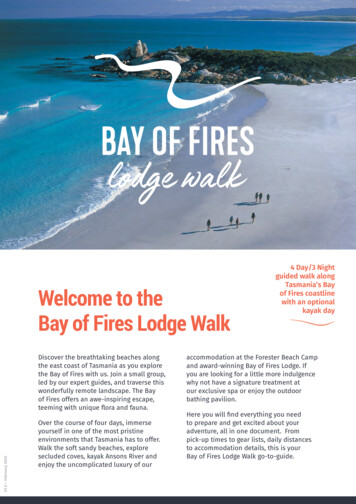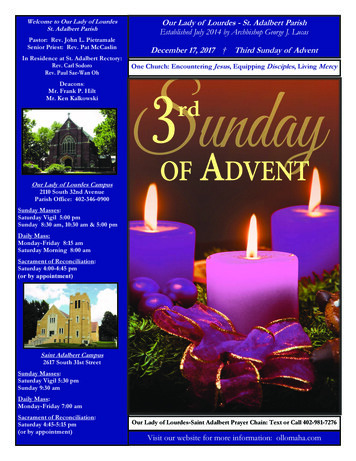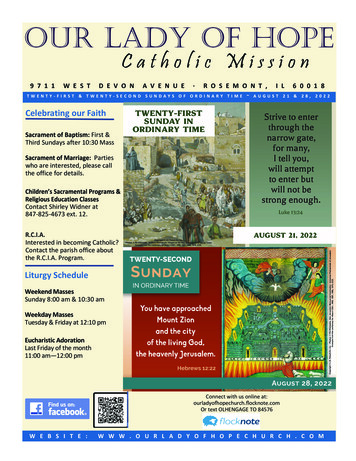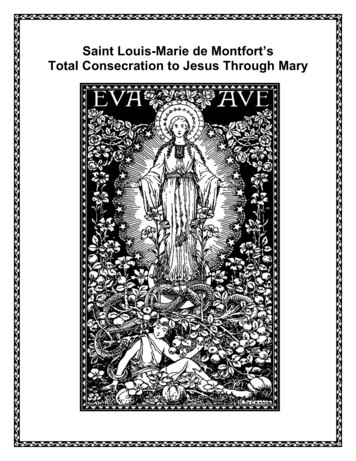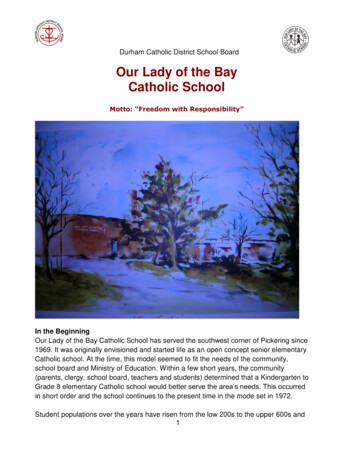
Transcription
Durham Catholic District School BoardOur Lady of the BayCatholic SchoolMotto: “Freedom with Responsibility”In the BeginningOur Lady of the Bay Catholic School has served the southwest corner of Pickering since1969. It was originally envisioned and started life as an open concept senior elementaryCatholic school. At the time, this model seemed to fit the needs of the community,school board and Ministry of Education. Within a few short years, the community(parents, clergy, school board, teachers and students) determined that a Kindergarten toGrade 8 elementary Catholic school would better serve the area’s needs. This occurredin short order and the school continues to the present time in the mode set in 1972.Student populations over the years have risen from the low 200s to the upper 600s and1
back to the present numbers seen in the school’s beginning. The building of newPickering Catholic schools and changing demographics account for these fluctuations.Our Lady of the Bay and the previous St. Mary Elementary School (now closed) in theRosebank area share a rich and unique, although brief, Catholic history set 300 yearsago, before Our Lady of the Bay Catholic School opened its doors.The first educator to set foot in the Greater Toronto Area was Father Fenelon. He was,by all accounts, a unique, Christ-like, larger-than-life member of the New FranceSulpician clergy who came from a tremendously wealthy family in France. He gave upthis life of wealth and ease to embrace the life of a missionary, and in very difficult times.He was an “Indiana Jones”-like character in the reality of a Catholic missionary andeducator. And just as the community asked Our Lady of the Bay to meet its educationalneeds in 1972, the Sulpician missionaries stationed at the Bay of Quinte were asked bythe Gandatsetiagon Aboriginal community to send a “Black Robe” to meet their needsbetween Frenchman’s Bay and the mouth of the Rouge River in 1669. Frenchman’s Baywas eventually named after this first Frenchman, Father Fenelon.The school’s name was selected at a regular Board meeting in 1967. Several nameswere forwarded, but trustee Shane Coburn’s submission was selected. The school’sproximity to Frenchman’s Bay and the fact that other boards had schools named “OurLady of the Air Ways” or “Our Lady of the Highway” figured heavily into the selection. Itwas also fitting that the parish church was Holy Redeemer and this school across thestreet would serve as a tribute to the Redeemer’s Mother.It was only after the intervention of the local Member of Parliament, the HonourableNorm Cafik, on behalf of the Board that a permit to build was granted. The originalschool site was purchased in 1966. Permission to build was granted by the Ministry ofEducation in 1967, subject to the usual submission of drawings and various soil tests.The Board had originally hoped to open the school in 1968, but this was delayed by oneyear.Mr. D. McCaul, a former chairman of the school board who lost his bid to be elected tothe combined board, was instrumental in negotiations for the land for the new school.The cost of the school was estimated to be around 360,000, but the final cost was 483,000.The famous Hall-Dennis Report, known as “Living and Learning,” came out in the 1960s.Educational implications centred on the concepts of freedom – freedom to explore,freedom to grow and learn at one’s own level, and freedom to advance at one’s ownpace. These changes touched on programming and expectations in the learning processas well as on the physical building that would promote these new dimensions in2
education. This could occur if schools were built without inside walls – with large, openareas capable of replacing two or three box-type classrooms. The ministry’s willingnessto grant funds to build an open concept school influenced the Board’s decision to planfor such a school. The school board hired William Saccoccio as architect, as he hadrecently built the Wm. G. Davis School in West Hill, which had become a model for theopen concept school.Another factor that played a significant role in the school’s initial evolution was that itwould be the area’s first senior elementary Catholic school (Grades 7 and 8 only). Thiswas the Board’s third plan. Originally, it was to be a Kindergarten to Grade 6 school,then Grades 6 to 8 only. (Extra grants were available for senior elementary schools.)John Henry was the first principal pf Our Lady of the Bay Catholic School. He wouldwork with Gerry Noonan, principal of St. Mary Elementary School (Rosebank area, butclosed now) and Mr. B. Chalmers from Holy Redeemer Catholic School.A group of 10 teachers began working as the staff of Our Lady of the Bay C.S. inSeptember 1968. As it turned out, they worked out of Holy Redeemer School C.S. on ashift basis from 1:00 p.m. until 5:00 p.m. each day – a procedure that lasted untilJanuary 1969, when the new Ontario County Board came into being.Mr. Donegan, a member of the original staff, was appointed Principal, as Mr. Henry (wholater would join the priesthood and serve at St. Isaac Jogues Church) had accepted aposition as Assistant Superintendent. Mr. Donegan’s task was to prepare to open a newtype of school, staff it and order the necessary materials to get it off the ground.He recalls walking the footings of the new school and using this process to help himdevelop a philosophy based on the open concept theory. The primary considerationgiven in the selection of staff was that they loved children.The school was not, in the end, ready to open in September 1969; staff and studentswould have to put up with alternate arrangements until approval was finally given tomove the students from the three feeder schools into the new building. Even though theworkmen were still laying carpet and putting final touches in all areas, Mr. Donegan andthe senior administration felt these were minor inconveniences compared to the onescreated by having the school split into three segments (St. Mary C.S., Holy RedeemerC.S. and St. Francis de Sales C.S.) The urgency of the move to new quarters wasevident in the manner in which it was carried out. The desks, textbooks and othersupplies were moved in on Friday, November 14, 1969. The staff worked throughout thenext day, Saturday, to create some semblance of order. An open house was held forparents and students on the Sunday. On Monday, November 17, the first school busesarrived with the first students to begin formal classes in the new building. Our Lady of3
the Bay Catholic School was finally a reality.The original staff membersMr. Donegan’s first message to students and parents follows.Principal’s MessageTo the students:These past two months, each of us have been burdened with inconvenience, temporaryaccommodation and, many times were tempted to toss in the towel. Unfortunately, somedid; however, most used the opportunity to develop responsibility and some degree ofself-discipline. For this I praise and thank you.Another experience is now upon us. Our Lady of the Bay will require even moreunselfishness and a high degree of personal responsibility. Bound together by mutualcooperation, understanding and charity, success will be ours, not only in academics, but4
in the joy that has always accompanied man’s unending search for truth. The challengeis before us.To the parents:So far this year, I have attempted to administrate Our Lady of the Bay School undertrying conditions. With your cooperation, my staff, and your children, we have survived.There will still be many problems to solve, adjustments to be made, and, of course,mistakes to be overcome. The key to all will be cooperation, dialogue, and a minimum ofcriticism.I'm sure both the home and the school must join together in a common goal if ourchildren are to be prepared for the world in which we live. Be assured of my support anda continuance of effort to provide the best education possible for your child.Please feel free to call me at any time.Yours sincerely,5
The first Grade 8 graduation program, June 25, 19706
The official blessing and opening of the school took place on Sunday, November 15, 19707
Rita Burns, Nicole Belair and Paul Cafik with Archbishop Pocock at the school’s blessingand opening.8
Principal Donegan, a student and Archbishop Pocock at the blessing and openingRita Burns’s Grade 8 Graduation invitation and diploma, 1970–1971. Rita was a memberof the first Grade 7 class to graduate.Challenges that were present in the first year increased in the second. The threegeographic areas being so widely diversified caused assimilation problems. The openconcept was still very uncomfortable for students, teachers and parents. Continuity inthe school was lost each year as 50 percent of the students left for high school. Mr.Donegan resigned the first year after an opportunity arose to continue his education fora short time. He eventually returned to the classroom, his first love. He had been a hard9
working administrator and the school grew through his efforts. He made one strongrecommendation that resonated with the school board: he suggested that the schoolbecome a Kindergarten to Grade 8 school.The 1971–1972 school year brought a new principal, John Brown. He arrived with muchexperience in team teaching in a senior school setting. The thought of working in asenior school appealed to him.As the year progressed, however, too much time was spent maintaining studentdiscipline in the open environment. There were too many students in each circle. Onehundred or more students in one circle with three teachers was overwhelming for bothstudents and teachers. All in all, there was a growing desire among the parents in thecommunity to have their own Kindergarten to Grade 8 school. The school boardconsidered these concerns, which led to Kindergarten to Grade 8 being implementedeffective September 1972 for children residing in the West Shore area of Frenchman’sBay.Many challenges presented themselves in the years that followed, but the staff,students, parents, school board and clergy continued to work as a co-operativecommunity to meet them. Mr. Brown left the school in 1976 and eventually became asuperintendent with the Board. Jim Johnston took over the reins from him. Under hiscare, the student population blossomed from around 200 to 600. The new school wouldsoon see 11 portables surrounding the main building before the new addition was put onin the 1980s; eventually, port-a-paks were installed, negating the need for portables asthe community’s enrolment began to decline.10
Principal Johnston and staff, 1980–1981The school’s third principal, Jim Johnston, published an exhaustive account of theschool’s inception and growth from the 1960s through the 1980s. It is kept in the schoollibrary.Jim Johnston firmly believed in the school’s motto, “Freedom with Responsibility”. Intime, his successful tenure at Our Lady of the Bay C.S. prompted the school board touse his extensive talents elsewhere: he was appointed to open St. Isaac Jogues, St.Anthony Daniel and St. Wilfrid Catholic schools.The following pictures, captions and anecdotes offer a glimpse of some of the students,educators, clergy, parents, community and support staff who have contributed (andcontinue to contribute) to the rich community that makes up Our Lady of the BayCatholic School.11
Grade 8 class with their teacher, Mr. T. Calnan, 1977–1978. Mr. Calnan, an outstandingathlete in his own right, spent most early morning, recess, lunch and after-school hourscoaching the many sports at the school. He followed Principal Johnston to St. IsaacJogues, St. Anthony Daniel and St. Wilfrid Catholic schools, always as the Grade 8teacher and coach of many successful teams. To this day he’ll say that Our Lady of theBay C.S. was his favourite school.12
Staff photo (1978–1979). Mr. H. Dzwonek (2nd row at left) followed Mr. Johnston to St.Isaac Jogues C.S., but was eventually drawn back to his favourite school. Mrs. A.McLaughlin (1st row at left) is one of the school’s present-day “Rosary Ladies.” Herchildren attended the school.The beloved Mrs. Power, Our Lady of the Bay Catholic School’s lunchroom and yardsupervisor for many years, is seen here receiving due recognition from former principalMrs. J. Binns for her outstanding assistance to and supervision of Kindergarten to Grade8 students. Mrs. Power knows all of the students in the school by name, and often theirlikes and dislikes as well.13
Madame Folosea’s Winter Carnival, with its many activities, snow sculpture competitionand of course Bonhomme, was always hugely popular with staff and students. MadameFolosea also used to organize a French fashion show. Students rehearsed and then sheorchestrated the 100 to 200 student models who would put on a performance in the gymfor the school and then later on a stage in the Pickering Town Centre for local shoppers.Madame was the longest-standing French teacher at the school and was instrumental inreinitiating the Grade 8 graduation trips to Quebec.14
Ms. J. Daigle, the school’s long‐time secretary, takes care of business and everyone atOur Lady of the Bay C.S. Her sense of humour and “reality checks” have kept sixdifferent principals, staff, students, parents, caregivers, grandparents, etc. informed andmore over the years.15
Durham Catholic District School Board Distinguished AlumniJan Heeney, who graduated from Our Lady of the Bay Catholic School in 1990, is nowassistant to the school librarian and often teachers (especially her former teacher). Shewas selected by the school board as Our Lady of the Bay Catholic School’s“Outstanding Alumni.”Jan Heeney, who has Down Syndrome, proved to be one of the most attentive anddedicated students in the school. Her positive attitude and approach to academics andschool life in general continued through her years at St. Mary Catholic SecondarySchool. Throughout her years in elementary and secondary school, and to this day, Janhas been extensively involved in the Special Olympics Program. She developed into askillful swimmer, rhythmic gymnast, track and field athlete and bowler. She has alsobeen a very active ambassador for the Special Olympics program over the years. Hercontributions at Our Lady of the Bay C.S. and in the community go above and beyondthe norm, helping to make her school and community a much better place.Knights of Columbus and Catholic Women’s LeagueThe Knights of Columbus have been very active in the school for many years throughthe Basketball Free Throw competition they run every year. Class winners can advanceto a group of schools competition and then on to a regional championship. Winners canfurther compete in the provincial championship.16
The Catholic Women’s League is also actively involved at Our Lady of the Bay C.S., withits Intermediate Grade 7 and 8 public speaking contest each year.Spotlight on Recent PrincipalsPrincipal Bryan Livett, from 1981 to 1986, brought his love of high-tech gadgets with himto Our Lady of the Bay C.S. He was on the cutting edge of the computer revolution,which was about to hit the school system. A talented musician, he had a voice to match.His sports love was volleyball, and he led his equally skillful staff at Our Lady of the BayC.S. to victory even against the high school Phys. Ed. departments in the annual boardchampionships.Principal John D’Costa arrived at Our Lady of the Bay C.S. in 1986 for one brief year.While teaching in Kenya, he moonlighted as a freelance journalist and photographer,garnering some recognition for his prize-winning photographs. He quickly put hisexperience to work as he moved up the board’s administrative ladder. Mr. D’Costa was ahighly organized administrator who motivated students and teachers to strive for more.He had a very positive effect on many of the school’s at-risk students.Principal Dave Hodkinson (1987–1990) was, at 16 years of age, the youngestprofessional soccer player in his day in the U.K. He eventually headed up the ProvincialAssociation of Principals. He still maintains his fitness and enthusiasm for soccer as abusy referee in Durham Region. Mr. Hodkinson often used his guitar and fine singingvoice to lead students in song at school and at school Masses.Principal Sheila Lynch (1991 to 1996) quickly went to work decluttering the old textbooksand various outdated articles in the school. She soon had the building repainted and hada fresh new environment ready for students and staff. Her strong emphasis onCatholicity was apparent during her tenure at the Bay. She had the challenging task of17
ushering in computerized report cards.Principal Ida Edgecombe (1996–2001) was always a big advocate for highlighting theachievements of students. Each month she would hold an assembly at which she wouldread out students’ accomplishments – academic, athletic, social or a combination ofthese strengths – at the Principal’s Awards assembly. She had a way of bringing out thebest in students and staff.Joanne Binns, who was was principal from 2001 to 2006, had a unique approach tofostering staff development and subsequently enhancing student academicachievement. While all administrators are concerned with the most vulnerable students,Mrs. Binns, with a strong background in Program Support, was a determined advocatefor the school’s growing staff of educational assistants, who were in turn caring for anincreasing student population of the most vulnerable, both physically and academically.The educational assistants grew in numbers from one to six as requirements increased.Mrs. Binns forever left her mark at the school in three ways. A very accomplished artist,she produced an amazing painting of the school complete with Virgin Mary subtlyhovering over the school (see the opening page of this history for the painting). She alsodeveloped with staff the school prayer now recited each morning during openingexercises. And she always encouraged students, staff and parents to strive to be thebest they coud be.Principal Rosemary Leclair was a computer savvy administrator who fostered schoolspirit and co-operation with her unique audiovisual recaps highlighting studentachievements at end-of-term assemblies. Mrs. Leclair always appeared organized,positive and friendly with everyone and was able to effortlessly garner respect fromstudents and staff, even though she was possibly the youngest on staff.Principal Michael Forgione (2008–present) brings a wealth of experience to Our Lady ofthe Bay C.S. He spent many years at St. Gregory, the first school in our board, datingback to 1859. It was one of his most rewarding schools because it was all about helpingchildren and families beyond the classroom. He often comments that he is happy to beworking in an environment with an experienced and dedicated staff at Our Lady of theBay C.S., with happy children eager to learn. Being right across the street from thechurch is an added bonus. His experience and consistent support for his teachers areappreciated by staff and show in the students’ achievements, both academically andathletically.Meet our Parish PriestsFather A.G. Quesnelle was one of the original trustees on the Pickering Separate Board,and through his and the Board’s efforts, was responsible for expanding the Catholicsystem of education in Pickering Township and for the building of Our Lady of the Bay18
Catholic School. As first pastor of Holy Redeemer Church, he had an important role inthe formation of church and school relations with the new Grade 7 and 8 students. Hissuccess in this area is evident in the annual Father Quesnelle Award, presented to theGrade 8 graduate who treats others with fairness, compassion and inclusion,recognizing the importance of the human person as a reflection of God.Father Jack Culnan made an immediate impression on the school and parish when hearrived in 1980. His extroverted, friendly personality endeared him to all who met him.He invited every staff member to his residence shortly after taking over the parish for asocial gathering to introduce himself and get to know everyone. He had a heart of goldand would go out of his way to assist people in need, even those outside of his parish.To be Christian is to be “Christ-like,” and he was that, in so many ways. The studentsand staff always looked forward to school Masses at the church because he consistentlypresented the message of the Mass in such interesting and novel ways. He was aheadof his time in terms of audiovisual presentations and captivating the congregation.Every priest has his own way of reaching out to his parish and the schoolchildren. FatherCharles Mahon was able to hold the students’ interest (a challenging task at the best oftimes) at Mass with his clear gospel messages.When Principal Forgione arrived at Our Lady of the Bay C.S., one of the first things hedid was invite Father Morosco Lett over to sports assembly, where he introduced himselfto the priest in front of the students. He then proceeded to present Father with a token ofthe school’s appreciation for his hard work in the parish. He made it clear that we, in amanner of speaking, considered Father Morosco the captain of our “spiritual team” atOur Lady of the Bay C.S., and so it was only fitting that he should have a team jersey.Father Morosco, never one who is lost for words, responded in a sportsmanlike manner.He is very personable and catches students’ attention whether at school Masses, duringclassroom chats, at school assemblies or in addressing graduates at end-of-yearcelebrations.Our VolunteersMany parent and community volunteers have assisted students over the years incountless ways. Parent volunteers run many of the activities that help make Our Lady ofthe Bay the strong, vibrant community school that it has been and is today: pizzalunches, Jump Rope for Heart, Parent Advisory Council, transporting students, collectingand counting money for deposits, the Fun Fair, fundraising, dance-a-thon, ARC, parentreaders, class trips, Cedar Park, library helpers, and more. The massive turnouts for theschool’s rich cultural dramatic presentations are also a tribute to the parent volunteersand the support they provide.Some have been members of the Parent–Teacher Association, which has gone by19
various names over the years. The name matters little in comparison to the innumerabletasks they perform to assist the school each year.Custodians of the BayMr. Donkers, Giles Jean, Tom Fitzpatrick, Jim Morrison, Al Henderson, Bill Dobbie, MarkDubyk, Rob Farnell, Dave Noonan, Bert, Andy and Roxanne Knapton have kept theschool, port-a-paks and portables clean, presentable and running day in and day out. Athankless task, but one that all students, parents and staff appreciate. We thank ourcustodians for their many years of hard work.Broadway at the BayDramatic stage productions have always been a staple at Our Lady of the Bay C.S.Dedicated teachers and administrators, along with students willing to highlight theirtalents, have entertained and thrilled the community for decades. In 1980, the musicalOliver! with its elaborate backdrop from CFTO and lighting to match, framed anoutstanding showcase of student singing, acting and dancing skill.20
In the early 1980s, Dave Hoover, the Grade 6 teacher, put on The Yellow Brick Road.Mr. Hoover went on to teach high school in Oshawa and became the board’s religionconsultant.21
Ursula Williamson arrived in 1996–1997 and taught Grades 7 and 8. In addition toteaching, she developed and enhanced dramatic arts until she retired in 2009. For manyyears, Mrs. Williamson, along with Ms. Hottot, Mrs. Barrie, Mrs. Sayer, Mrs. Benton, Mr.Rorrison, Mr. Kempton, Mr. Kapular, and numerous other teachers, parents and formerstudents, prepared students from the primary through intermediate grades for monthsbefore they performed in what became known as Broadway at the Bay. Theseperformances were always a big hit with other schools during the day and with parents,grandparents and friends in the evening. Mrs. Williamson had the ability to select,develop, choreograph, sequence, time and utilize the strengths of all her assistants toput on the show successfully. A few photos of these productions are found below.22
23
24
25
The Rosary LadiesThe “Rosary Ladies” come regularly to the school to pray the Rosary with the students.Mrs. Mary Bridgeman, Mrs. Cecelia McCaughey, Mrs. Wey, Mrs. Encarnation and Mrs.Audrey McLoughlin have been coming to the school for many years to help the studentsenhance their spiritual lives.26
27
Our Patron SaintOur school is blessed to have Mary as our patron saint. Mary was named after Mariam, thefamous sister of Moses. She was born in Jerusalem to Joachim and Ann. Mary lived in avillage in Galilee, in a house built of mud and stone. Her life was as normal as that of othergirls in the village. Mary learned a lot about life from the people of Nazareth. They weresimple people, full of life in spite of the shortages associated with poor people’s lives. As ayoung teenager, she was engaged to Joseph, a carpenter in Nazareth. She was to bemarried a year later.But God had different plans for her. God sent an angel named Gabriel to tell her it wasGod’s wish that Mary give birth to Jesus. The Virgin Mary gave birth to Jesus and becameknown as “Mother Mary” – mother not only to Jesus, but to all of us.School PrayerBlessed Mary, Mother of God,watch over us atOur Lady of the Bay Catholic School.Guide our hands, feet and voices to follow your son, Jesus.Help us to be respectful of all,to be thankful for our blessingsand to always do our best.Let us make our school a peaceful place,where everyone is welcomeand friendship and knowledge grow.Amen.PrincipalsJohn Henry (1968–1969)Mr. T. Donegan (1969-1971)John Brown (1971-1976)Jim Johnston (1976-1981)Bryan Livett (1981–1986)John D’Costa (1986-1987)Dave Hodkinson (1987–1991)Sheila Lynch (1991–1996)Ida Edgecombe (1996 to 2001)Joanne Binns (2001–2006)Rosemary Leclair (2006-2008)28
Michael Forgione (2008–present)Contributors:Tom McLoughlin, long-time teacher at OLB (10 years in Special Education, 10 years inGrades 5 to 8, and 12 years in program support) who was also involved with all sportsand most activities at the school;Jim Johnston, former principal and author of “Early Years’ History” of the school29
The school's name was selected at a regular Board meeting in 1967. Several names were forwarded, but trustee Shane Coburn's submission was selected. The school's proximity to Frenchman's Bay and the fact that other boards had schools named "Our Lady of the Air Ways" or "Our Lady of the Highway" figured heavily into the selection. It



